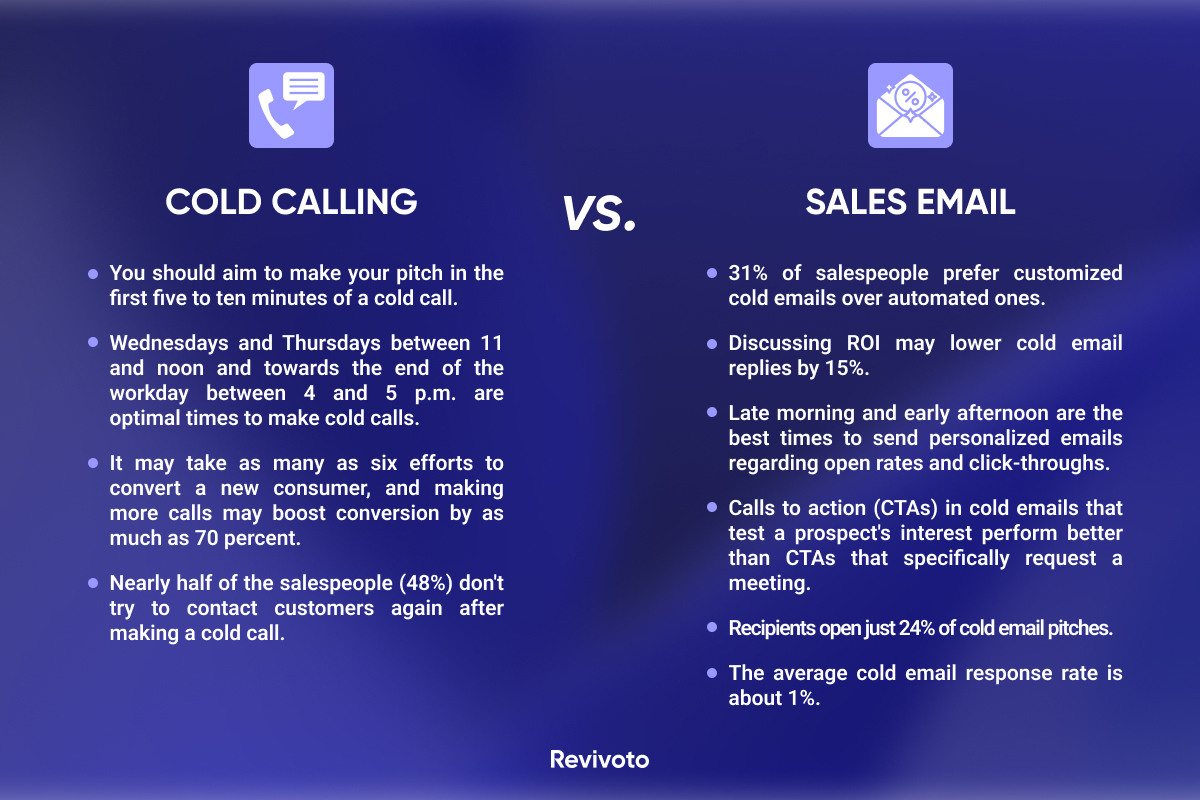Communication is at the heart of everything you do; as a real estate agent and professional, you must constantly look for innovative methods to create leads. Today, cold calling vs. sales email is an essential topic of discussion in this industry.
Making a practical initial touch with a prospect is a delicate process for sales representatives, whether they are describing the purchase process to a first-time buyer, making an offer on behalf of a seller, or advertising through social media, their website, or their blog.
The “outreach” technique sales representatives employ to initiate contact substantially impacts response rates. It’s important to utilize both email and cold calling while marketing for a real estate sale. Volume and convenience against straightforwardness is the distinction between the two.
Managing sales emails often requires less time and effort than making cold calls, but making cold calls is more effective at generating meaningful replies because of the more personal nature of the interaction. In this article, we will discuss sales emails and cold calls to assist you in choosing the way that your prospect would be most receptive.
Table of Contents
What Is Cold Calling?
Cold calling is a common way to generate new leads in the real estate industry. Real estate agents use this tactic to acquire new clients, which entails contacting potential clients by phone and marketing the services they provide.
Typically, real estate brokers have no previous relationship with the clients they contact. When a phone call comes in, a real estate salesperson first introduces themselves and determines whether the person on the other end is a potential customer. Realtors may swiftly qualify leads and get contact information from homebuyers by properly promoting their services to a broad audience.
While introducing oneself and selling your services over the phone requires skill and planning, it may be an effective technique for growing your customer base as a realtor.
Before incorporating cold calling into your real estate marketing strategy, you must understand what makes a cold call productive. Successful cold calls must instantly convince the target to listen to your message and arrange more conversation. When planning a cold call pitch, keep the following key components in mind:
- Maintain a warm demeanor and an optimistic tone
- Provide clear information to clients regarding your real estate services
- Communicate a specific, attainable objective to the prospective buyer
- Describe your experiences and familiarity with the area
What Is the Goal of Cold Calling In Real Estate?
Real estate agents might find people interested in buying or selling properties via cold calling. A real estate salesperson may convert a total stranger into a paying customer after a quick interaction. Moreover, you may utilize the information you get from cold calls to establish a list of potential customers interested in your product or service.
The benefits of cold calls:
- Conserving money
- Identifying local businesses
- Obtaining feedback from a wide range of people
- Boost outbound sales
What Is a Sales Email In Real Estate?
A cold or sales email is sent to a prospective customer with whom you have no prior contact. It’s the email equivalent of a cold call, with the primary distinction being that sales email campaigns are far more readily automated and scalable.
If you’re sending sales emails, ensure not to include erroneous or misleading sender information in fields. Additionally, you must state that your email is an advertisement and provides recipients with an opt-out mechanism.
Why Should You Send Cold Emails?
There are several reasons why real estate agents should use cold email as a lead generation method. You may use cold email to:
Save both time and money
Once established, the majority of email campaigns need little management. Compared to other lead creation techniques, using cold email to create leads may help real estate agents save a lot of time. This is also a cost-effective strategy.
Reach customers effortlessly
Emails are read on smartphones, desktop and laptop computers, and tablets. Sales email in real estate allows you to interact with buyers despite their preferred mode of communication.
Increase your lead-generating capacity
The primary benefit that sales email provides is its scalability. Once a cold email campaign is put up, it takes the same amount of time and effort to send it to many recipients, making it an excellent approach to expanding your sales process.
Cold Calling vs. Sales Email In Real Estate
Sales emails and cold calls in real estate are both successful prospecting methods. To reiterate the already stated fact, the distinction between the two is volume and convenience vs. straightforwardness. In contrast to the time-saving aspect of sending sales emails, making cold calls to prospective customers might lead to immediate answers.
Let’s dissect some of the critical distinctions between a cold call and a sale email:
Cold calls have the potential to be more personal
When compared to sales emails, a cold call has the potential to be both more personal and active. Because they enable you to tailor your plan to a prospect’s demands as the discussion advances
Cold calls can be annoying
Cold calls are inherently invasive. People typically aren’t receptive to getting them regularly. Additionally, you may get upset and impatient if the call does not go well.
Sales emails are more easily scaled
Sales emails are more cost-effective and efficient, which makes them highly scalable. Additionally, you may supplement a sales email with more aesthetically attractive and helpful information.
Prospects are more likely to ignore emails
The main drawback associated with sales emails is that they will be disregarded. Cold emails are often banned, remain unread, or are deleted.
Cold emails are easy to send and trace
Prospects may be more kind in their rejection of a cold email than they would be in reaction to a cold call since the former is less invasive. Additionally, they can be sent automatically, tracked, and forwarded, making distribution and monitoring much simpler.
Which to choose: Emailing or Calling
Before deciding whether to email or call, keep the following in mind.
Time and the weekday
Later in the workday throughout the week, people are more likely to answer their phones and create phone interactions. In contrast, the optimal period for sending emails is shorter but more frequent. Draft emails throughout the day, but sending them by 10 minutes before or 10 minutes after the hour is better. Sending an email when a buyer is most likely to check their inbox will ensure that it gets seen first.
The request
Define your goal for the initial outreach. You should decide whether to phone or send an email based on how compelling your ask is. A cold call is beneficial for requests such as meetings, conferences, and free samples of products. You can send emails to consumers if your request can be satisfied in a few short lines of text.
The position of the potential customer
Cold calling is a preferable option for buyers at the management level or above. Since lower-level professionals spend most of their time away from their workstations (traveling, working in groups, attending meetings, etc.), asynchronous channels like email are ideal for communicating with them.
The customer characteristics
Age, occupation, industry, and other factors all shape the preferences of various consumer personas. Younger buyers prefer connecting through email over the telephone. Those working in more traditional fields are used to mainly communicating by telephone. So consider buyer personas if you choose between cold calling and emailing.
The deal flow
However, calling your potential customer may be the quickest and easiest option if they are unresponsive, unsure, or stuck in a bureaucratic maze. If they pick up the phone, you can request and obtain a response right away; otherwise, you can leave a voicemail and follow up with an email.
Cold call vs. email statistics

Tools for cold outreach
Check out these tools to help your efforts in cold outreach whether you opt to concentrate on making phone calls, sending emails, or doing a combination of the two.
HubSpot
You may use the free HubSpot software to keep track of your cold email approach. By using this tool, when a potential client interacts with your email, it will let you know immediately.
Outreach
Outreach is a platform that allows customers to manage all of their prospecting operations in one location, make outbound calls, and send emails with customized content.
SalesLoft
SalesLoft is a centralized platform for sales calls and messaging. You can make cold calls directly from the platform, and your conversations will be recorded and tracked for future reference. The pre-recorded voicemail drop is a valuable function in SalesLoft since it eliminates the need to leave the same message repeatedly.
Icebreaker by UpContent
When performing cold outreach, the Icebreaker tool by UpContent can assist you in comprehending what to say. This platform gathers pertinent third-party material to assist you in fostering deeper relationships with your contacts. Additionally, it can discover interesting articles and interact with your CRM, allowing you to determine which material provides results.
Conclusion
Real estate salespeople must always seek innovative methods to connect buyers and sellers. Cold calls and sales emails are both effective ways of generating leads fast and economically. One should consider their circumstances and future goals before deciding which method to follow.
FAQ
Introduce yourself and state from where you are calling. Before proceeding, check whether you’re speaking with the right person. If you want to take the customized approach, say something in common to help transition from the introduction to the purpose of the call.
Create attention-grabbing subject lines, avoid using generic introductions, and adjust the length of the email’s content to suit the readership best. Not only should you send emails at the appropriate time and provide value with a follow-up message, but you should also avoid talking about yourself, include a clear call to action and next steps, and send the email.
Email newsletters, acquisition emails, retention emails, and promotional emails are the most common marketing emails.


